Every discerned traveler knows that if you want to get acquainted with the country and explore it in all its authenticity, savour its character and uncover what sets it apart from its neighbors, you should favor local, untouristed places over the popular crowded ones found on the average traveler’s itinerary. Hidden art gems over the well-known gallery collections, family-owned authentic osterias tucked away from the limelight instead of bustling restaurants with scenic views but bland menus which have nothing to do with the local culture. And, perhaps most telling of a country’s character, small towns with less tourists coming in, the ones that only true connoisseurs know about. Here is our list of small yet enchanting Italian towns and villages, each one beautiful in its own unique way — offering a chance to savour the taste of authenticity that traditional tourist routes simply cannot provide.
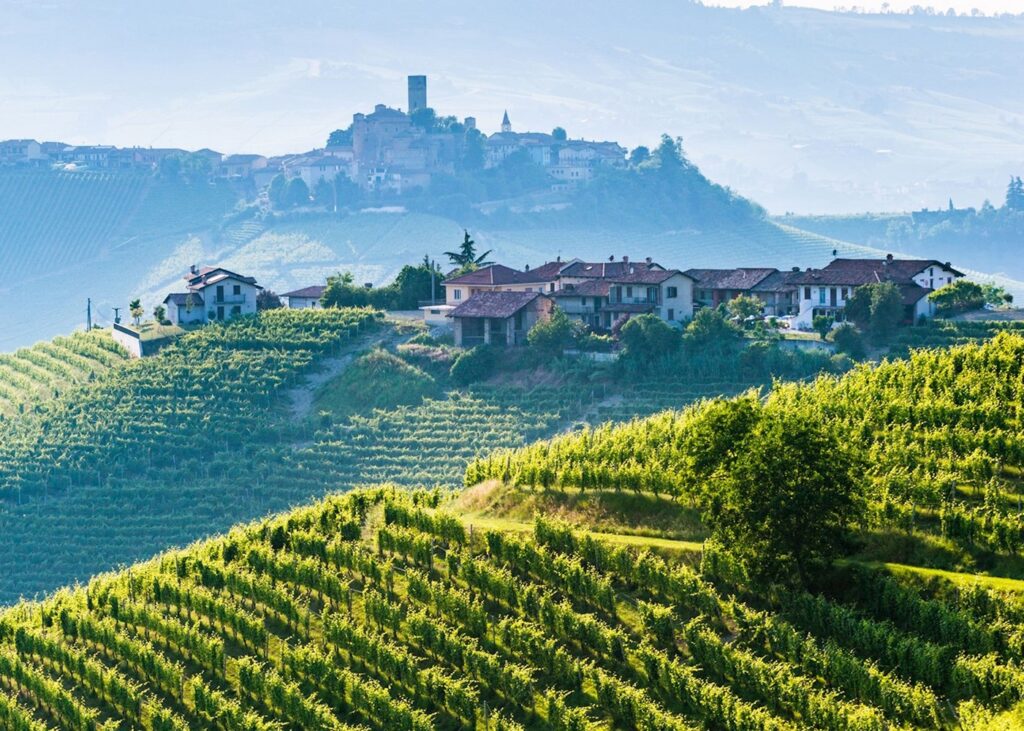
Nestled in the rolling Langhe hills, the medieval village of Barolo stands as the proud birthplace of Italy's most revered wine. This picturesque hamlet, crowned by its ancient castle housing the fascinating WiMu Wine Museum, breathes history in every cobblestone and vineyard. The surrounding slopes, where only select growers cultivate the prized Nebbiolo grapes, produce the robust Barolo wine that has captivated connoisseurs worldwide.
Beyond its liquid treasures, Barolo enchants visitors with its timeless charm. The autumn air carries the earthy aroma of white truffles from nearby Alba, while family-run trattorias serve handmade tajarin pasta draped in velvety sauces. A short drive reveals breathtaking vistas from hilltop villages like La Morra, where panoramic views stretch across vine-covered valleys to the distant Alps. The Museum of Peasant Civilization offers a poignant glimpse into the agricultural traditions that shaped this extraordinary terroir.
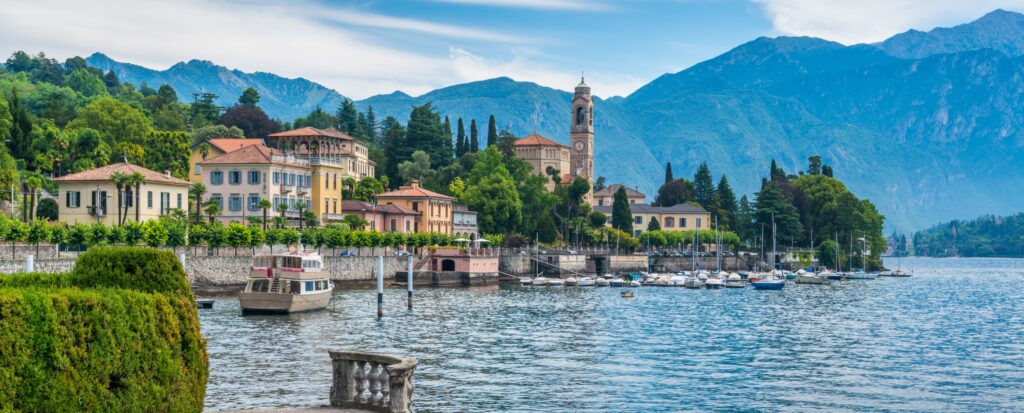
Perched on Lake Como’s western shore, Tremezzo is a postcard-perfect village framed by mountains and elegant lakeside villas. Its refined beauty stems from its 17th- and 18th-century merchant families, who built grand Baroque palaces adorned with frescoes, marble floors, and antique furnishings.
Once a retreat for European nobility, Tremezzo boasts landmarks like Villa Carlotta, with its lush gardens and art collection. Even Greta Garbo’s character praised its charm, calling life here "divine" in the 1932 film Grand Hotel.
A hidden treasure is Parco Civico Teresio Olivelli, a quiet lakeside park with an 18th-century octagonal pavilion offering stunning views. With its rich history and timeless elegance, Tremezzo remains one of Lake Como’s most enchanting destinations.
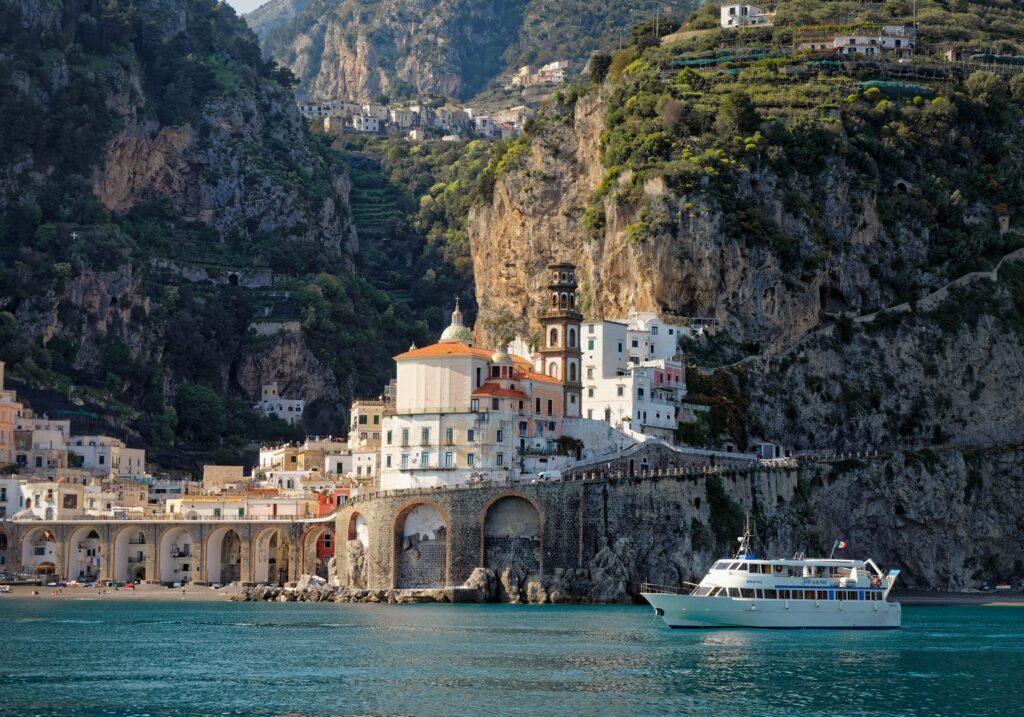
Clinging to the cliffs between sea and sky, Atrani holds the distinction of being Southern Italy's smallest town – a pristine medieval fishing village that has preserved its ancient soul far better than its famous neighbor Amalfi. This UNESCO-listed labyrinth of whitewashed houses tumbling down to a tiny piazza feels like walking into a living nativity scene, where every narrow alley, hidden courtyard, and flower-draped staircase tells centuries of stories.
The heartbeat of Atrani pulses in its pedestrian maze. From the striking staircase of San Salvatore de' Birecto church to the medieval passageways unchanged since the Maritime Republic era, time moves differently here. Unlike the polished tourist hubs nearby, Atrani's authenticity shines through its thousand-year-old churches like Santa Maria Maddalena and in traditions like the annual sarchiapone feast – where locals stuff locally-grown green pumpkins with ricotta, cured meats, and generations of culinary wisdom to honor their patron saint.
Here in Atrani, mornings begin with fishermen mending nets on the petite beach, afternoons drift by in sun-dappled alleyways, and evenings bring the scent of citrus over rooftops.
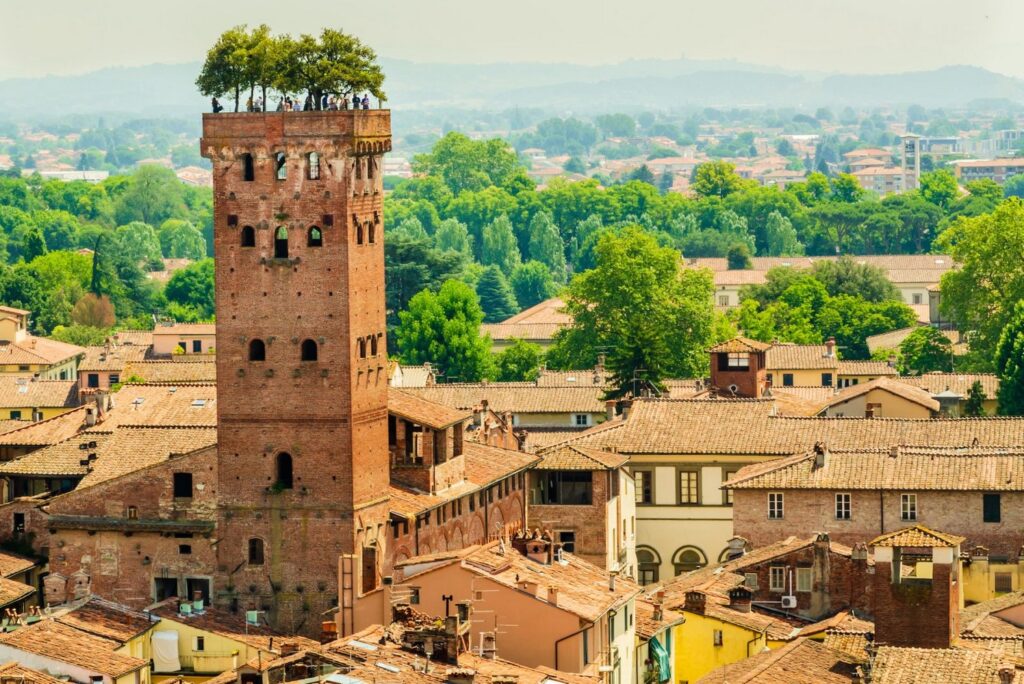
Encircled by its magnificent 16th-century walls — among Italy’s few fully intact fortifications — Lucca is a living postcard of medieval Tuscany. Unlike other cities that outgrew their defenses, Lucca transformed its 4km-long, tree-lined ramparts into an elevated park, offering panoramic views over terracotta rooftops and the surrounding countryside.
Within these bastions lies a harmonious Roman grid of cobbled alleys, Romanesque churches, and hidden piazzas. The Guinigi Tower, crowned with its iconic holm oaks, and the Pfanner Palace’s Baroque garden whisper of Lucca’s golden age as a silk-trading powerhouse. Deeper in the historic center, legends linger at the Devil’s Bridge, where the Arno’s waters swirl beneath an ancient arch, and in the Palazzo Bernardini, where a mysteriously curved stone jamb is said to bear the devil’s curse.
The Volto Santo crucifix in San Martino Cathedral — with its haunting, soul-piercing gaze — has drawn pilgrims for centuries. Yet Lucca’s true magic lies in its unhurried rhythm: cyclists gliding along the walls at sunset, locals debating over espresso in Piazza dell’Anfiteatro, and the scent of farro soup wafting from trattorias.
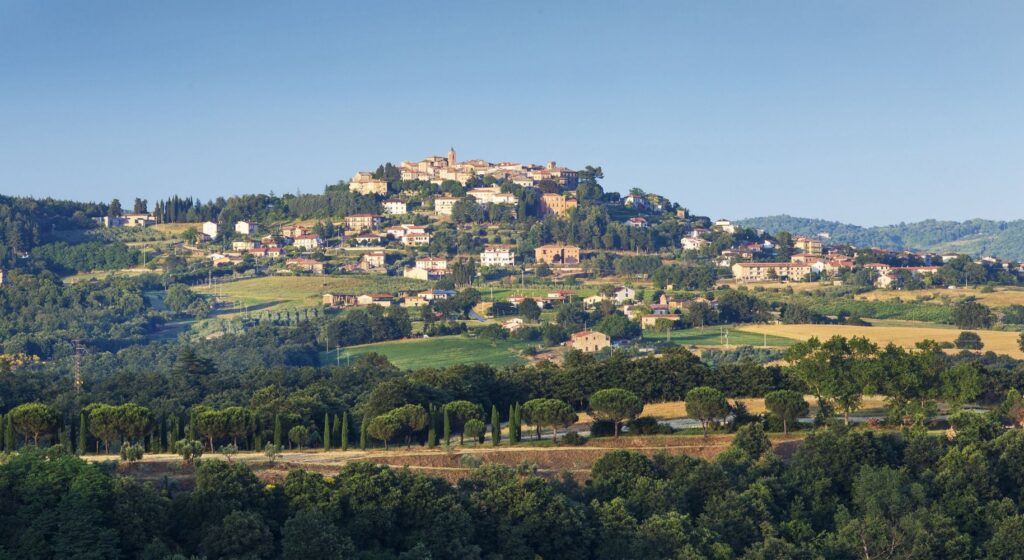
Perched on a sun-drenched ridge where Umbria brushes against Tuscany, this honey-colored hamlet, framed by undulating vineyards and silver-green olive groves, moves to the rhythm of rustling leaves and church bells rather than tourist crowds.
At its heart, the Torre Mozza (the "Blunted Tower") stands as a sentinel over San Francesco Church, where Renaissance frescoes glow in the candlelight. Nearby, the Castle of Monteleone’s weathered stones whisper of medieval power struggles. But the real marvel is the Teatro dei Rustici — a jewel-box theater carved from a 1732 granary by enterprising youths who simply wanted to stage Carnival comedies.
Wander Via Mazzini’s serpentine alleyways (once called "Via Dritta" and "Via Torta" — "Straight Street" and "Crooked Street"), where geraniums spill from wrought-iron balconies. Below the village, hiking trails unfurl through a patchwork of vineyards producing Orvieto’s golden DOC wines, while the Città della Pieve’s Piero della Francesca masterpieces lie just 10km away.
There are no queues, only conversations with winemakers at twilight. No souvenir shops, just the scent of wood-fired bread mingling with wild thyme. This is Umbria as it was, and still is: unhurried, unfiltered, and utterly unforgettable.
If you would like to explore Italy deeper, remember: the most authentic experiences come from wandering without an agenda, saying "yes" to unexpected invitations, and letting these ancient places reveal their stories at their own pace.
The Sun Secret Collection travel designers will be pleased to craft a personalized journey — handling all the details so you can simply soak in the beauty of authentic Italy.
Buon viaggio — may your Italian adventure be as unforgettable as the country itself!
The luxury hospitality landscape is being transformed by a new generation of properties that push boundaries — whether through groundbreaking architectural design, hyper-local cultural programming, or unprecedented levels of personalized service. From a historic retreat embodying Florence’s scholarly elegance to a Burgundian château reborn, a canal-side Amsterdam landmark, a vibrant London sanctuary, and a secluded Baja beachfront escape — these five extraordinary properties are set to captivate discerning travelers in 2025.
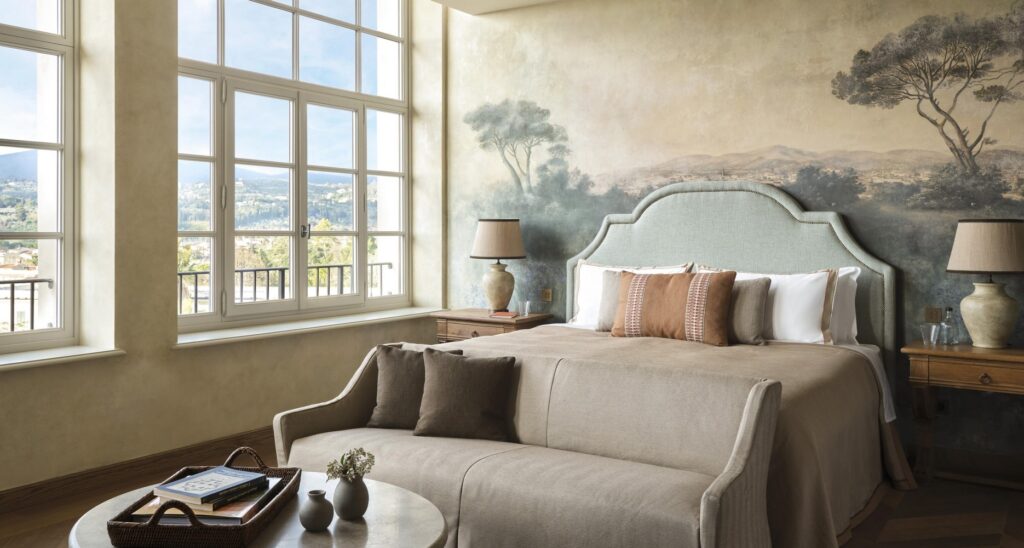
Once educating Florence's elite from its airy hillside campus, the Collegio's privileged location offered scholars inspiration from both city and countryside — a duality preserved in its new incarnation as a luxury retreat. Housed in an 18th-century boarding school just two miles from the Piazza del Duomo, this Auberge Resorts Collection property offers 83 exquisitely designed rooms, including Grand Suites spanning up to 2,292 square feet.
Guests are greeted by sweeping views — gaze at the Duomo di Firenze from one window, then turn to rolling Tuscan vineyards from another. The hotel’s historic charm shines through its restored chapel (now a dream wedding venue) and Bar Bertelli, a sultry cigar lounge once the headmaster’s office.
Culinary delights await at La Gamella, where an open kitchen invites guests to savor Cicchetti-style Italian fare and enjoy an aperitivo. For all-day dining, Conservatorio serves timeless classics, while Café Focolare offers poolside Florentine specialties beneath the Tuscan sun.
The Aelia Spa embraces Tuscan healing traditions with treatments infused with olive oil, lemon, and local herbs.
The hotel arranges private viewings of Michelangelo’s "David" and other iconic Florentine masterpieces.
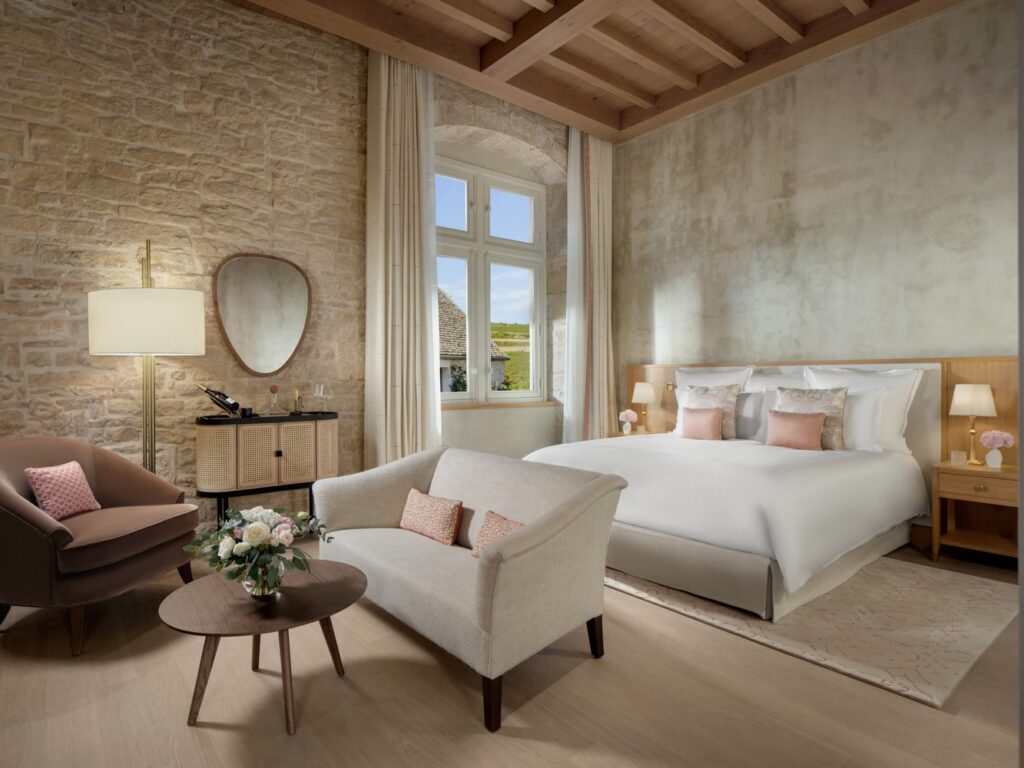
A 12th-century Burgundian estate reimagined for the modern connoisseur, Château de la Commaraine is set amid the storied vineyards of Pommard, just 2.5 miles from Beaune. Following a meticulous four-year restoration, this 37-room sanctuary blends medieval grandeur with contemporary elegance.
Original white stone walls, intricate wooden ceiling vaults, and a neutral palette honor the château’s heritage, and some of the rooms offer vineyard views. Elevating the experience further, a secluded four-bedroom residence boasts its own temperature-controlled tasting sanctuary — perfect for private comparisons of the domaine's most coveted crus. Under the guidance of Meilleur Ouvrier de France Christophe Raoux, two dining venues — a cellar restaurant and a casual bistro — showcase French gastronomy. Within the château's 14th-century tower, now transformed into an intimate wine salon, sommeliers guide guests through rare Burgundian vintages by candlelight, while outside, the 18-meter heated pool mirrors the sky above Pommard's vine-clad slopes.
Beyond the estate, guests can embark on Wine Safaris, hot-air balloon rides over the vines, or canal sailings, immersing in Burgundy’s rich viticultural legacy.
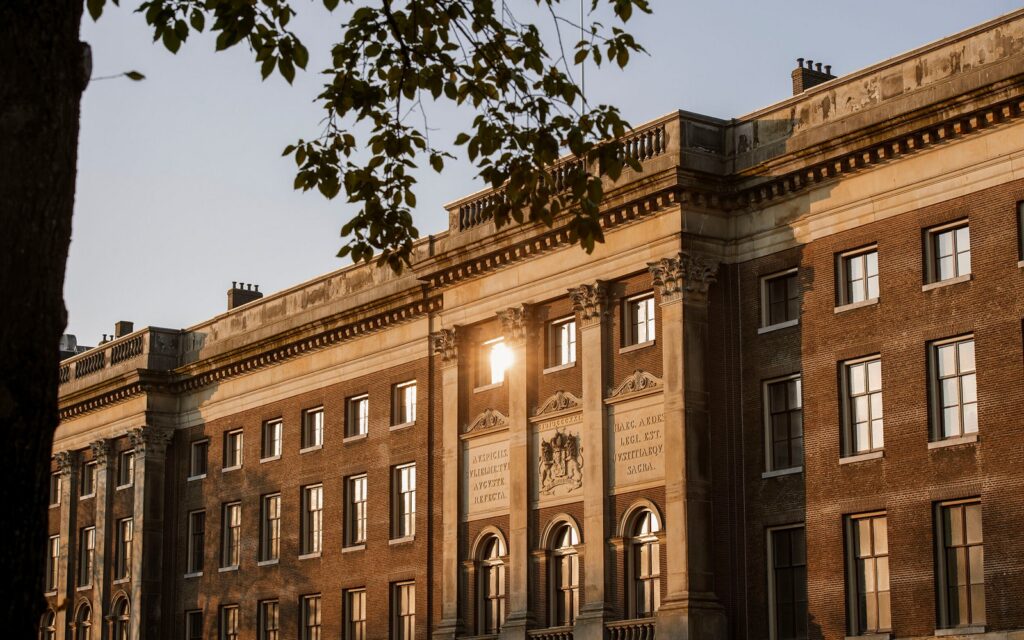
In the heart of the UNESCO-listed Canal District, Rosewood Amsterdam breathes new life into the former Palace of Justice, a 1665 landmark. After a decade-long transformation, the hotel blends Dutch heritage with contemporary luxury, offering 134 rooms (including five signature suites) with canal or courtyard views. As Amsterdam enforces strict limits on new hotel developments to preserve the city’s historical integrity and cultural heritage, this property represents one of the final luxury hotels approved under the city's 'Hotel Stop' policy.
Designed by Studio Piet Boon, the interiors honor the building’s judicial past — cellblocks reimagined as chic spaces, courtrooms turned into event venues. Three distinct restaurants and bars, including an in-house distillery, celebrate gezelligheid (Dutch coziness).
For seamless transitions between Amsterdam's iconic landmarks, the hotel offers private canal cruises aboard an elegant salon boat designed by Piet Boon — its rich teak decks and supple leather seating reflecting the city's maritime heritage.
The hotel features the magnificent 223-square-meter ballroom, where original judicial chamber details now form a dramatic backdrop for glittering soirées.
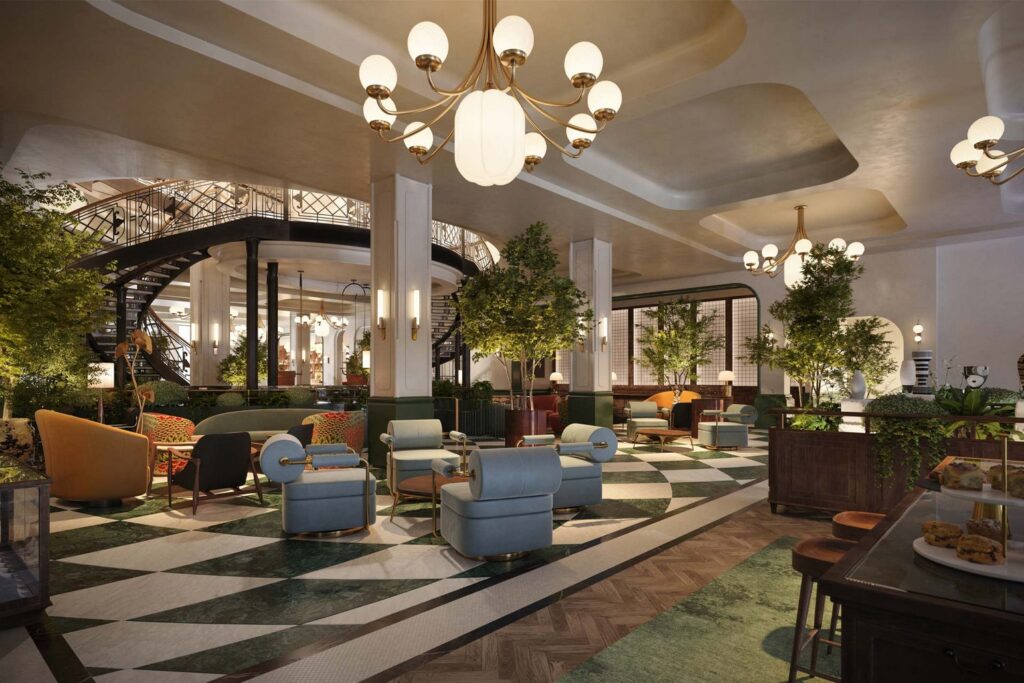
Bringing its wellness-focused hospitality to the heart of London, Six Senses will transform the historic Whiteley building into an urban sanctuary. This carefully restored Art Deco landmark in Queensway just moments from Hyde Park will house 109 guest rooms, 14 branded residences, and innovative social spaces designed to foster connection and rejuvenation.
The property thoughtfully balances its heritage setting with contemporary comforts. Guests will discover inviting public spaces including a botanical-inspired lobby lounge, an all-day restaurant, and a tranquil courtyard offering respite from the city's energy.
At the heart of the experience lies the expansive Six Senses Spa, responding directly to urban lifestyle needs. Spanning 325 square meters, the wellness facilities include a 20-meter indoor pool, cutting-edge fitness areas, and the signature Alchemy Bar for personalized treatments.
The concept evolves further with Six Senses Place on the second floor — a members' club blending work, leisure and wellness. Through its curated mix of coworking spaces, social lounges, and treatment rooms, the club aims to nurture both professional creativity and personal growth.

Nestled along the pristine shores of Baja California's East Cape, Amanvari emerges as Aman's newest retreat, where the essence of "peace" and "water" — reflected in its Sanskrit-derived name — comes to life. This secluded beachfront property harmonizes with its dramatic desert-meets-ocean landscape, offering a serene escape amid the rugged beauty of the Sea of Cortés.
The resort features a collection of pavilion-style accommodations, private Aman Residences, and intimate dining venues celebrating Baja's coastal flavors through local ingredients. Guests can unwind at the beach club, immerse themselves in the Aman Spa's holistic wellness programs, or explore the untouched shores of its private white-sand beach.
Designed to mirror the peninsula’s natural isolation, Amanvari blends organic, contemporary architecture with seamless indoor-outdoor living. Floor-to-ceiling glass walls frame panoramic ocean vistas, while shaded terraces and courtyards invite moments of quiet contemplation. The resort’s layout evokes an archipelago-like tranquility, with elevated structures appearing to float above the landscape and ground-level spaces encircled by reflective pools.
For those seeking a deeper connection to this remote escape, the Aman Residences offer a permanent retreat. These villas embody the Aman philosophy of understated luxury, with open-air living spaces, private gardens, and unobstructed views of the sea and star-filled skies.
2025 brings an exceptional collection of new properties worth discovering. Should you wish to be among the first to experience them, the Sun Secret Collection will craft your perfect journey — from priority bookings to tailored experiences, our team will ensure every moment is unforgettable. Contact us to begin planning your next luxury escape.
Dubai is set to redefine urban transportation with the introduction of fully electric air taxis in early 2026. This bold leap into the future of autonomous air travel will provide a seamless, cutting-edge, and eco-friendly alternative to conventional transport, revolutionizing the way people move across the city. Imagine soaring above the city’s iconic skyline, bypassing traffic-clogged roads, and reaching your destination in mere minutes.
Designed to seamlessly connect key locations, the air taxi service will link luxury hotels, bustling business districts, and Dubai International Airport, making travel effortless and exhilarating. Soon, passengers will be able to take a swift, affordable 10-minute flight between some of Dubai’s most famous landmarks, transforming the way people experience this dynamic metropolis.

Dubai’s flying taxis are expected to arrive in early 2026, with initial operations launching from four key vertiports located at Dubai International Airport, Downtown Dubai, Dubai Marina, and Palm Jumeirah. These vertiports allow air taxis to take off and land vertically without the need for runways, making them ideal for a densely populated urban environment.
The air taxis will carry a pilot and four passengers, flying at speeds of up to 200 miles per hour. A journey between Dubai International Airport (DXB) and Palm Jumeirah will take approximately 10 minutes, a significant reduction from the usual 45-minute drive. Flights will operate at altitudes between 1,000 and 3,000 feet, ensuring passengers remain connected to mobile networks throughout their journey.
The dream of flying cars has existed for centuries, deeply rooted in myths and visions of the future. Ancient legends, such as the Greek tale of Icarus, reflected humanity’s desire to conquer the skies. In the 20th century, the fascination with airborne transportation took a tangible form. The 1950s saw futuristic concepts like Frank Tinsley’s “flying saucer for everybody,” which envisioned personal flying crafts making any backyard a potential airport. The idea of vertical take-off and landing (VTOL) aircraft gained traction in the 1960s, when legendary aviation pioneer Igor Sikorsky predicted the need for city-to-airport air transport. However, he noted the technological limitations that made helicopters the only viable option at the time.
As urban congestion worsened in the following decades, interest in flying cars continued to grow. Throughout the late 20th and early 21st centuries, Hollywood and science fiction played a crucial role in keeping the concept alive, portraying futuristic cities where aerial taxis replaced road-bound vehicles. The development of drone technology and electric aviation in the 2010s marked a turning point. Advances in battery technology, electric propulsion, and automation fueled serious efforts to create real-life flying cars. Today, eVTOL aircraft represent the closest realization of that dream, offering quiet, efficient, and environmentally friendly urban air mobility solutions.
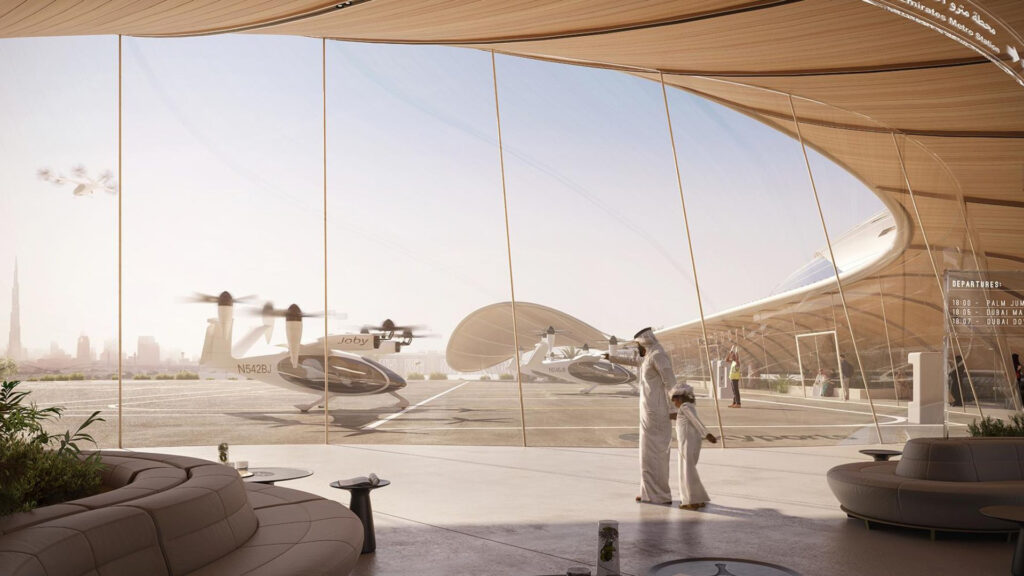
With increasing global concerns over climate change, electric Vertical Take-Off and Landing aircraft have emerged as a sustainable alternative to traditional transportation. In alignment with its broader sustainability goals, Dubai has committed to transitioning to zero-emission operations by 2050.
The introduction of air taxis is a crucial component of this strategy. Dubai’s air taxis will contribute to several key environmental benefits, including a reduction in emissions, as they are electrically powered and produce zero emissions, significantly lowering the carbon footprint compared to conventional vehicles. They also generate far less noise than helicopters or traditional cars, improving the quality of life in urban environments.
Dubai is not just adopting flying taxis for convenience — it is pioneering a new era in urban mobility. The city’s long-term vision includes expanding the network to include routes between Dubai and Abu Dhabi, further integrating air taxis into everyday transportation. Initially piloted, these aircraft are expected to transition to fully autonomous systems as the technology advances, making them an even more seamless part of the urban landscape.
Besides reducing road-traffic congestion, air pollution, and carbon emissions, analysts predict that eVTOL aircraft could eventually replace helicopters, significantly reduce intra- and inter-city travel time, and become a huge tourist attraction. By combining innovation, sustainability, and efficiency, Dubai is set to create a transportation system that other global cities will seek to emulate.
Luxury living is evolving, and nowhere is this more evident than in the meteoric rise of branded residences. Once the domain of five-star hotel groups, this exclusive real estate sector now attracts an array of high-end brands — from legendary fashion houses to elite automotive names — each infusing their signature aesthetics and prestige into private residences.
As of 2024, the global branded residential market is valued at an astonishing $66 billion, according to a study by Luxonomy, a leading luxury industry platform. Over the past decade, the number of branded residences has surged by 150%, reflecting a growing demand among discerning homeowners for a blend of exclusivity, world-class service, and investment value.
Traditionally, hotel-branded residences have set the gold standard, seamlessly merging five-star hospitality with private homeownership. Esteemed names like Four Seasons, Mandarin Oriental, and Aman offer residents a turnkey lifestyle with personalized services, premier amenities, and the prestige of a globally recognized brand. However, the trend has expanded far beyond the hotel industry. Luxury powerhouses such as Bentley, Lamborghini, Armani, and Missoni have ventured into the space, crafting residences that reflect their unique brand philosophies through bespoke design, curated experiences, and unparalleled attention to detail.
Branded residences embody a refined way of living, where every element is designed to immerse residents in a brand’s world. From exquisite interiors to impeccable service, these homes offer a blend of style, convenience, and prestige. For those who seek a lifestyle as curated as their wardrobe or car collection, branded residences represent the pinnacle of modern luxury.
In this feature, we explore some of the world’s most breathtaking branded residences, where architectural brilliance meets the art of living.
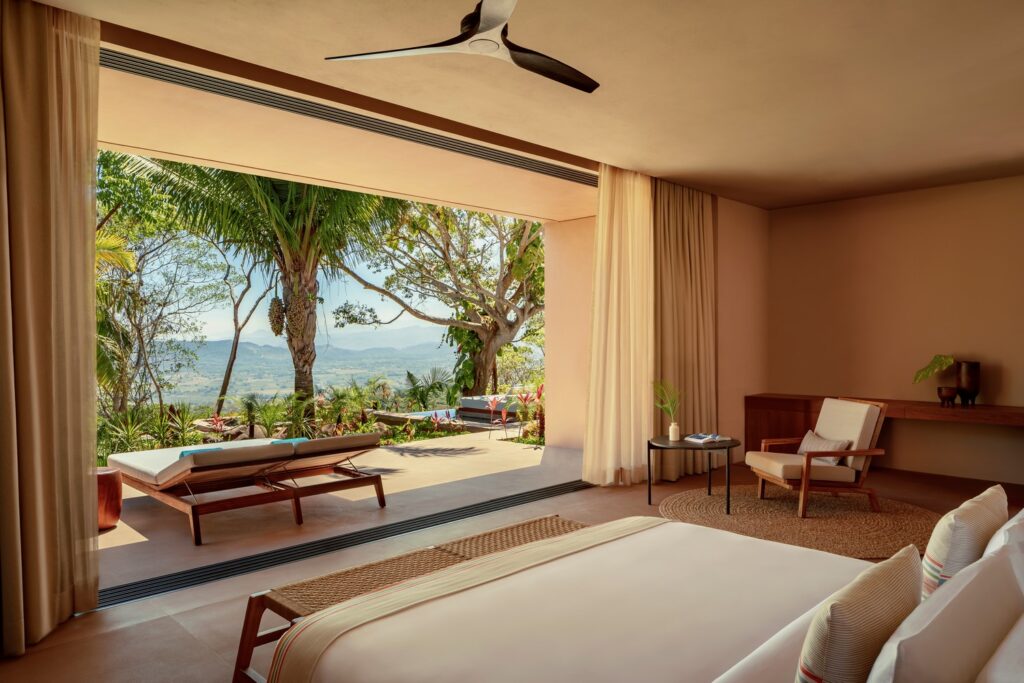
Nestled within one of Mexico’s last untouched tropical beachfront rainforests, One&Only Mandarina is a secluded retreat where contemporary luxury harmonizes with the untamed beauty of nature. Perched along the dramatic cliffs of Riviera Nayarit, this exclusive enclave of 55 private villas offers a seamless blend of chic resort living, tranquil seclusion, and immersive outdoor adventure.
Residents enjoy privileged access to the resort’s world-class amenities, including a 42,000-square-foot immersive kids’ club, a sophisticated beachfront lounge, and a pristine mile-long stretch of swimmable coastline.
Owning a residence here means waking up to panoramic views of the Pacific Ocean and the Sierra de Vallejo mountain range, with endless opportunities to unwind in your private infinity pool, enveloped by lush jungle canopies. Each villa is designed to harmonize with its breathtaking surroundings, offering a refined yet organic aesthetic that embraces open-air living.
The residences, envisioned by renowned architect Rick Joy, feature an array of customization options. Homeowners can select from curated furnishing packages or personalize their spaces with bespoke additions such as a private gym. For those seeking a truly tailor-made retreat, the design team offers the flexibility to adapt floor plans, ensuring that each home is a one-of-a-kind masterpiece.
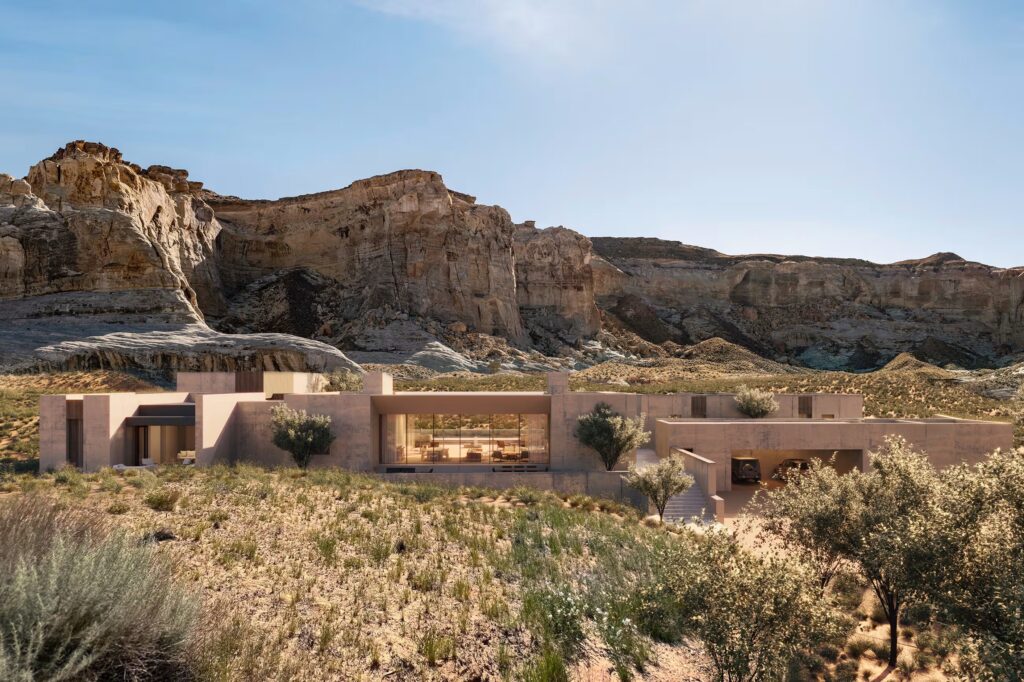
Set against the breathtaking backdrop of canyons, mesas, and desert ridges, the private residences at Amangiri redefine modernist luxury in harmony with nature. Designed by Marwan Al Sayed, the visionary architect behind the iconic Amangiri hotel, these exclusive homes seamlessly blend architectural precision with the raw beauty of the Utah wilderness.
Each residence is a masterpiece of bio-mimicry, where textures and tones mirror the surrounding landscape — poured concrete walls reflect the desert’s hues, and private pools evoke the natural watering holes that form after desert rains. Designed to enhance the harmony between architecture and topography, the residences offer an unparalleled connection to the landscape.
Beyond their striking design, the Amangiri Residences serve as sanctuaries of peace and introspection. Far from everyday distractions, yet enriched by Aman’s world-class services and amenities, these homes offer a space to reconnect — with oneself, with nature, and with loved ones. Positioned at a respectful distance from the hotel, each residence offers a private desert retreat while still granting effortless access to the Aman lifestyle. At Amangiri, luxury is more than an aesthetic — it is a profound, meditative experience, deeply rooted in the spirit of the land.
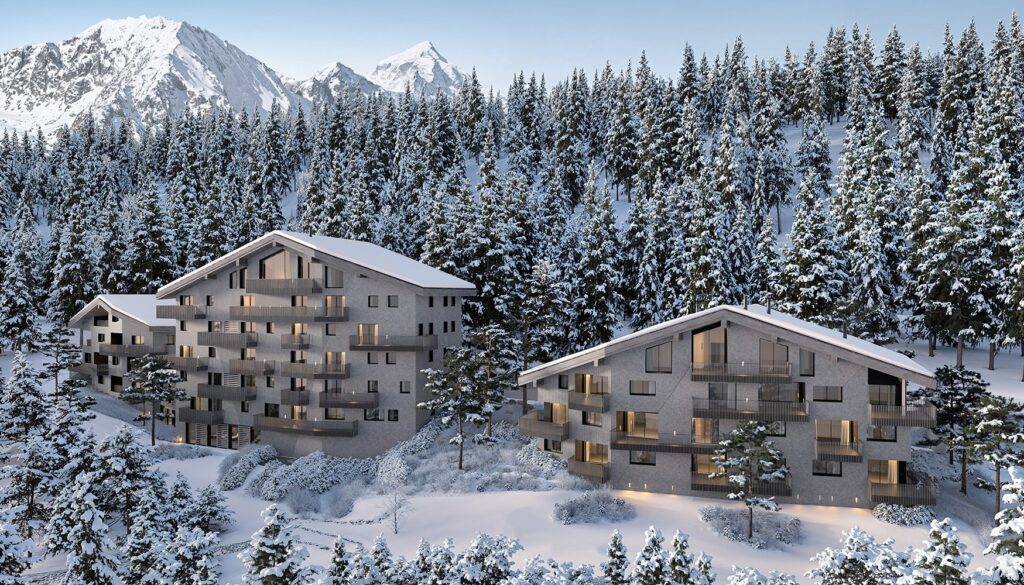
Set against the breathtaking backdrop of the Swiss Alps, FENDI Private Residences in Crans-Montana merge traditional chalet charm with contemporary elegance. Designed by Marco Costanzi, the creative mind behind FENDI Private Suites in Rome, these residences reflect the brand’s dedication to craftsmanship, with Valmalenco stone facades, warm oak wood interiors, and geometric motifs inspired by Karl Lagerfeld’s designs. Curated furnishings by FENDI Casa, artistic lighting by Mario Nanni, and contemporary artworks complete the refined aesthetic.
Spanning 6,700 square meters, the development includes three residences, expansive private units, and luxury hotel suites. Sustainable building practices, including high-efficiency insulation and renewable energy integration, ensure a harmonious connection with the Alpine environment. The sleek stone-clad exterior takes inspiration from the Astuccio cape, designed by Karl Lagerfeld for FENDI in 1971.
A dramatic cliffside pool integrates harmoniously with the natural rock formations, offering panoramic mountain views. The spa, featuring a jacuzzi, sauna, hammam, and treatment rooms, provides an exclusive retreat. Additional amenities include a fitness center, ski lounge, and a dedicated yoga space, while concierge services and private chefs ensure an effortless lifestyle.
Set for completion in 2026, FENDI Private Residences in Crans-Montana redefine Alpine luxury, combining Swiss craftsmanship with the brand’s unmistakable design signature.
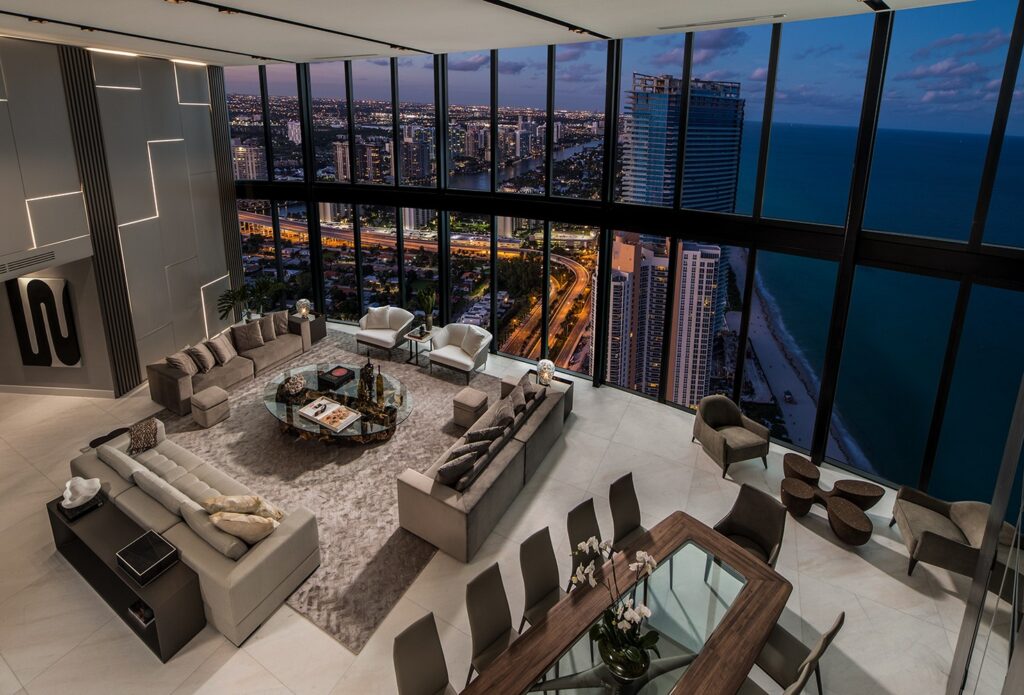
Rising above the shores of Sunny Isles Beach, Porsche Design Tower Miami brings innovation and exclusivity to oceanfront living. This 132-residence tower features the groundbreaking Dezervator — a high-tech elevator that transports both residents and their cars directly into their homes, offering an unmatched level of privacy and convenience.
Beyond its automotive ingenuity, the tower features world-class amenities, including a private restaurant, ocean-view lounge, and climate-controlled wine lockers. Residents can enjoy a private cinema, golf simulator, and racing simulator, while dedicated car concierge services provide valet assistance and vehicle maintenance.
Positioned between Bal Harbour and Aventura, the Porsche Design Tower offers spectacular views of the Atlantic Ocean and Intracoastal Waterway. With two and a half miles of pristine beachfront, world-class dining, and luxury shopping nearby, this address embodies the pinnacle of engineered luxury.
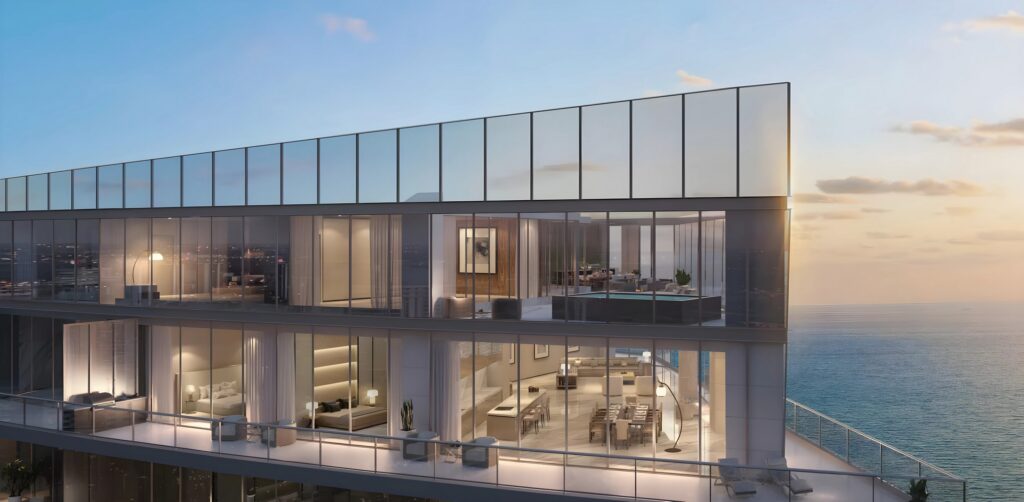
Soaring 60 stories above the coastline, Armani/Casa Residences in Miami set a new standard of oceanfront sophistication. Designed to embody Giorgio Armani’s signature aesthetic, the tower’s sail-like structure creates a striking silhouette on the skyline, complementing the natural beauty of the Atlantic.
The 260 residences feature floor-to-ceiling windows that frame panoramic views of the ocean, Intracoastal Waterway, and city skyline. Interiors reflect Armani/Casa’s hallmark of understated luxury, with expansive private terraces and summer kitchens enhancing the seamless indoor-outdoor lifestyle. Most residences also offer private high-speed elevator access for an added sense of exclusivity.
A curated selection of high-end amenities elevates the experience, from a full-service spa and state-of-the-art fitness center to a private cinema, cigar lounge, and oceanfront cabanas. Residents enjoy access to a private white sand beach, where the horizon stretches endlessly over aquamarine waters.
A testament to Armani’s timeless vision, Armani/Casa Residences in Miami transcend traditional living, offering refined elegance for those who seek the exceptional.
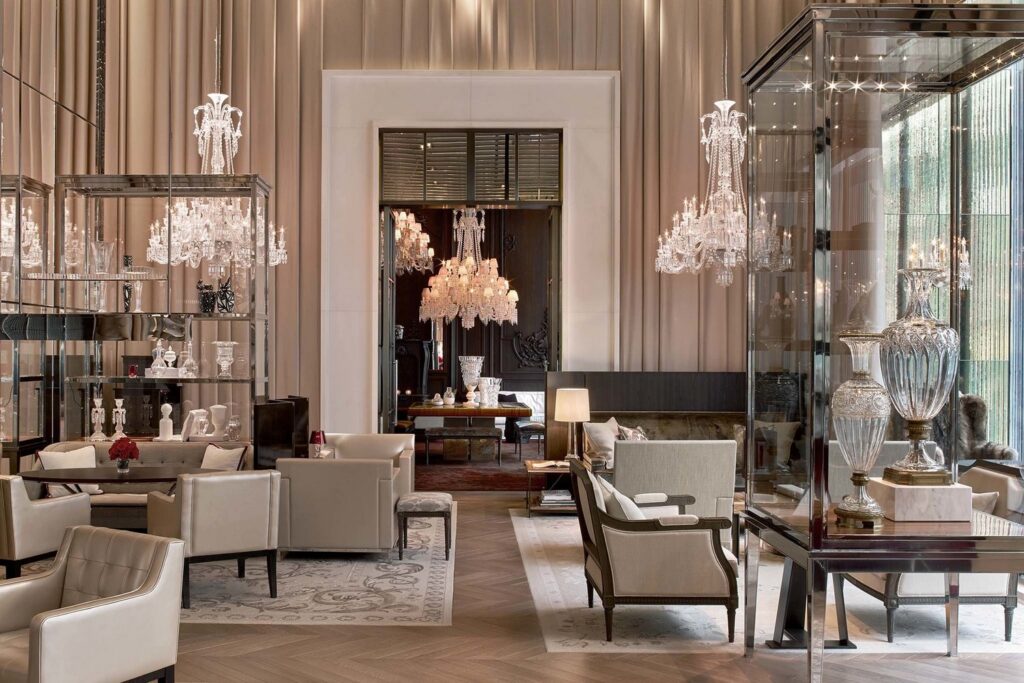
Standing at the crossroads of Fifth Avenue and 53rd Street, Baccarat Residences New York brings an exquisite fusion of French craftsmanship and contemporary Manhattan luxury. Rising above the Baccarat Hotel, this exclusive collection of residences occupies the 18th through 49th floors, offering a refined living experience just steps from the Museum of Modern Art.
Designed by the acclaimed architectural firm Skidmore, Owings & Merrill, the 60 residences embody the artistry and precision of their legendary namesake — the esteemed French crystal house. Beyond the 60-foot prismatic glass façade, interiors are crafted to reflect Baccarat’s signature elegance with impeccable attention detail.
Residents enjoy a private lobby and concierge services, along with full access to the world-class amenities of the Baccarat Hotel. From 24/7 room service to exclusive spa, pool, and fitness privileges, every element of hospitality is seamlessly integrated into daily life. More than just a residence, Baccarat offers an immersive experience of luxury, where timeless French heritage meets the vibrant energy of New York City.
Dubai is a city where luxury knows no limits, and its hotels are no exception. From opulent skyscrapers to serene desert retreats, these iconic properties redefine extravagance with unparalleled service, breathtaking design, and world-class amenities. Whether it’s round-the-clock butlers, private infinity pools, or panoramic views of the Arabian Gulf, these hotels set the gold standard for indulgence. Here are five of Dubai’s most legendary hotels, where luxury is not just a standard — it’s an art form.

Atlantis The Royal
Atlantis The Royal is Dubai’s ultimate expression of luxury, pushing the boundaries of extravagance with its bold design and world-class amenities. Home to 795 rooms and suites, 17 restaurants, 17 boutiques, and 90 swimming pools, this hotel is made for those who want to experience Dubai in its most lavish form. Cloud 22, its sky-high infinity pool, offers unparalleled views, while 44 suites and penthouses feature private glass-sided pools, allowing guests to swim in the sky.
Designed by Kohn Pedersen Fox Associates, the hotel moves beyond the Atlantis The Palm’s underwater theme, embracing light, space, and elevated luxury. Its sprawling spa is a sanctuary of indulgence, featuring a salt cave, hydrotherapy pool, hammam, and chromotherapy sauna, with treatments incorporating local ingredients like oud, dates, and Gulf Sea salt. The hotel’s environmental initiatives include marine conservation, educational programs, and scientific research focused on the surrounding area.
Jumeirah Burj Al Arab
When Jumeirah Burj Al Arab opened on December 1, 1999, it was the tallest hotel ever built at 321 meters and quickly became known as the world’s first seven-star hotel — a testament to its unmatched opulence. With gold leaf, marble, and 210 custom crystal installations, its lavish design exudes grandeur.
More than just a hotel, Burj Al Arab became a symbol of Dubai’s ambition, cementing its status as an icon of luxury. Twenty-five years later, it remains a benchmark for extravagance, featuring over 30 types of marble, bespoke furnishings, and record-breaking indulgences like the world’s most expensive cocktail and the largest tin of caviar.
Beyond its striking design, exemplary service defines the experience. Michelin-starred chefs, expert mixologists, florists, and private butlers cater to every detail. The hotel even has its own camel, Musafir, and a fleet of Rolls-Royces and BMWs for seamless city exploration.
A quarter-century since its debut, Jumeirah Burj Al Arab remains the gold standard of luxury hospitality, continually setting new benchmarks in service and sophistication.
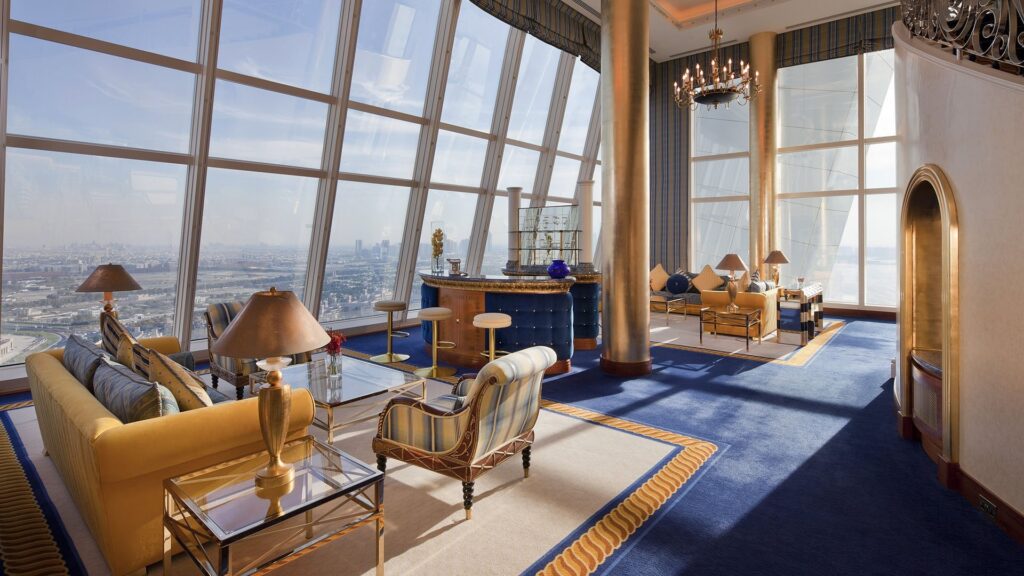
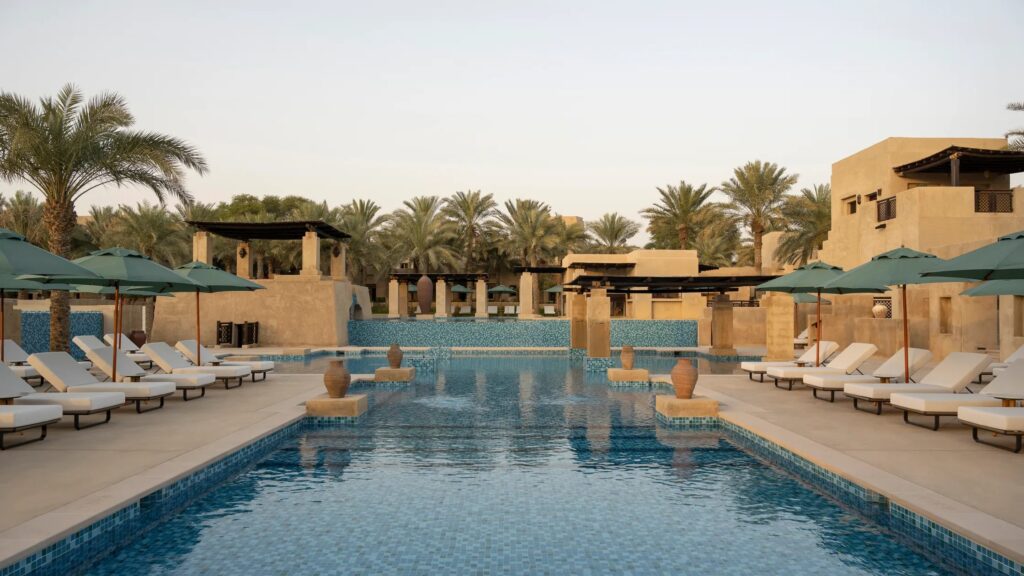
Bab Al Shams Desert Resort
A serene desert resort designed to resemble a traditional Arabian fort invites you to leave behind the bustle of Dubai and unwind amidst golden dunes. Just a short drive from Dubai, this resort combines traditional Arabian architecture with modern luxury. Recently renovated, the resort features 115 spacious rooms and suites designed with light, airy interiors, while still maintaining authentic Arabian elements.
Beyond its stunning design and exceptional cuisine, Bab Al Shams offers a wealth of activities that allow guests to immerse themselves in the desert landscape. Whether it’s taking a camel ride through the dunes, enjoying the live performances or simply relaxing by one of the three large swimming pools, this resort provides an ideal blend of relaxation and adventure. Bab Al Shams Desert Resort is a hidden gem that captures the essence of Dubai’s heritage, offering a serene, luxurious escape in the heart of the desert.
As the sun sets, Al Hadheerah, the resort’s outdoor restaurant, comes to life with live music, traditional performances, and an immersive dining experience under the stars, making every moment at Bab Al Shams a true escape into Arabian heritage.
Bvlgari Resort
Bvlgari Resort Dubai blends traditional Middle Eastern architecture with the refined elegance of Milanese design. Located on the man-made island of Jumeirah Bay, the resort features 101 rooms and suites, as well as 20 villas with private pools and gardens. Designed by Antonio Citterio Patricia Viel, the resort’s low-rise structure is complemented by expansive balconies offering views of the Arabian Gulf or the Dubai skyline, while Mashrabiya-style latticework brings a sense of local heritage to its luxurious design.
The resort’s true opulence is evident in the suites and penthouses. Forty-four of these accommodations feature private glass-sided pools suspended in the air, while the penthouses boast expansive indoor living and dining areas, as well as large landscaped terraces. The marble-clad bathrooms, complete with tubs overlooking the Arabian Gulf, add to the resort’s grandeur. Every suite and penthouse comes with complimentary airport transfers, personalized butler service, and daily breakfast.
High-end amenities of the resort, in line with the brand’s philosophy, offer both elegance and substance. Guests can indulge in the Bvlgari Spa, stay active at the fitness center, unwind at the exclusive beach club, and enjoy the luxury of the Marina and Yacht Club. The five dining venues serve exquisite international cuisine, enhanced by the legendary Italian hospitality that defines Bvlgari.
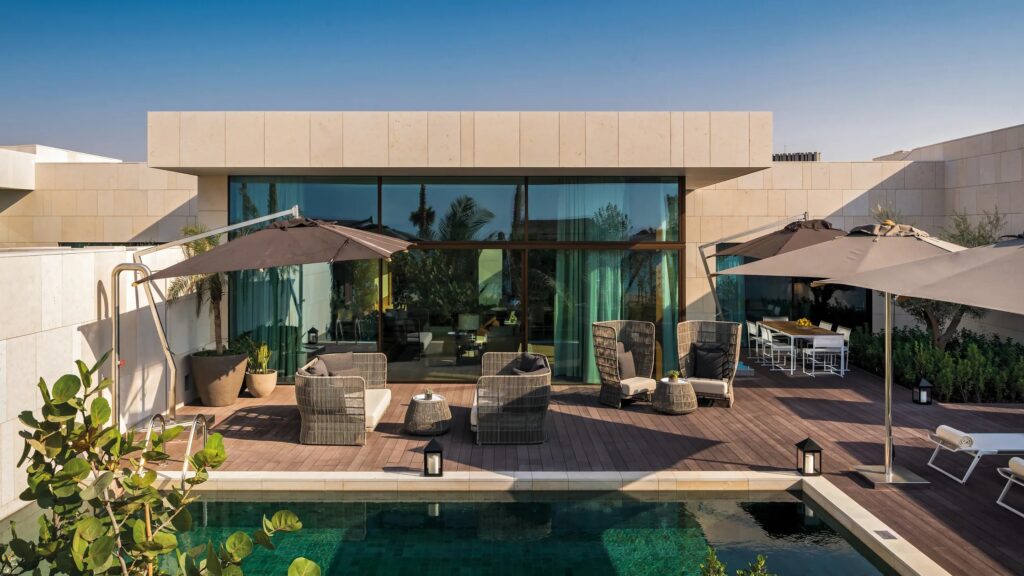
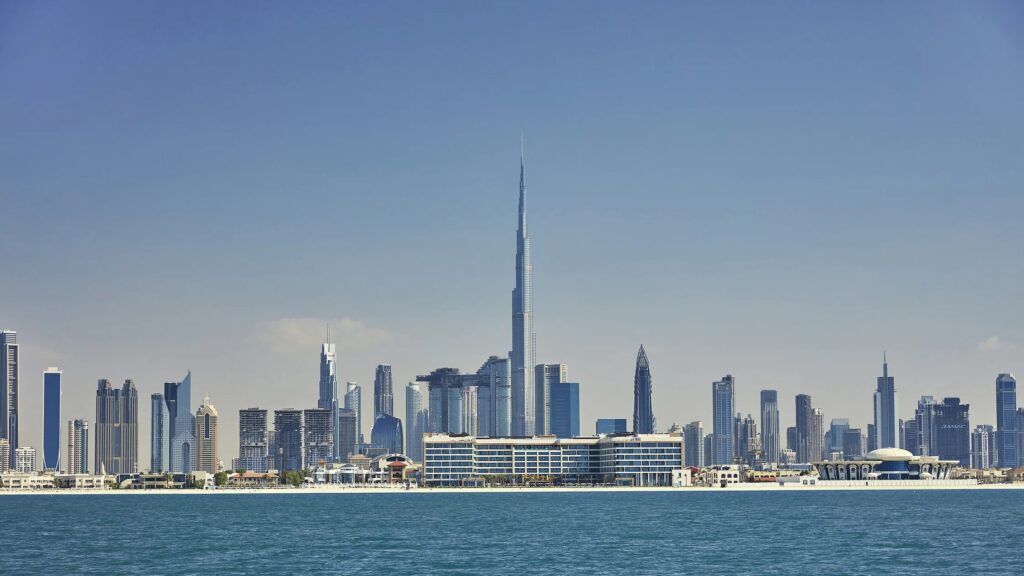
Mandarin Oriental Jumeira
Mandarin Oriental Jumeira, Dubai, is a refined beachfront retreat that blends contemporary elegance with relaxed luxury. Overlooking the Arabian Gulf and Dubai’s glittering skyline, the resort’s prime oceanfront location sets the stage for both tranquil days by the water and sophisticated evenings under the city lights.
The rooms and suites reflect Mandarin Oriental’s signature sophistication, with interiors in warm earth tones accented by tangerine, teal, and gold. Premium materials such as Statuario marble and Persian travertine enhance the sense of understated luxury, while floor-to-ceiling windows, balconies, and terraces frame breathtaking views of the Arabian Gulf or the Dubai skyline.
The spa is a epitome of wellness, inspired by the region’s natural landscape, from dune-like curved ceilings to deep blue flooring reminiscent of the sea. Offering Asian and Arabic-inspired treatments infused with 24-karat gold, the spa provides separate relaxation spaces for men and women.
Heading to the “top of the World” is an unforgettable experience that changes us and the way we see the world. As you walk towards the North Pole you will be walking in fact on a moving ocean of ice. An ocean with floating monoliths and a palette of whites, blues and greys as far as the eye can see. It is a terrifyingly alien landscape that evokes the sublime.
A white vastness that only sees a single sunrise and sunset every year that had fascinated explores and artists for centuries because of its extraordinary beauty.
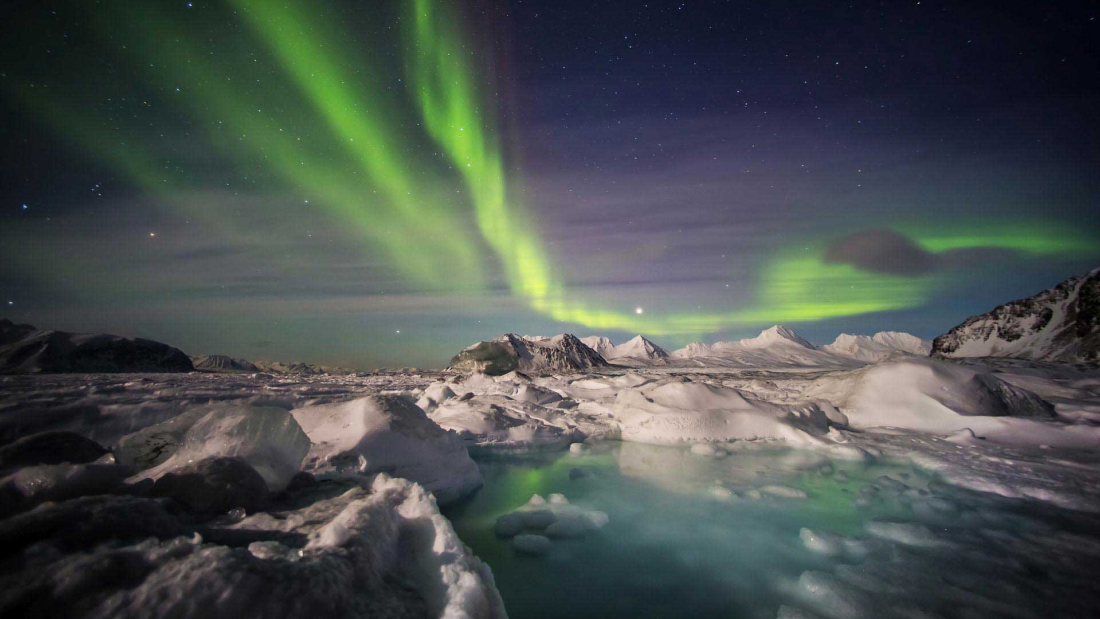
Onboard of a sumptuous private yacht of your choosing, we will start our cruise to explore Greenland, the Arctic Circle and the North Pole. A journey of wonders where one of the most rejuvenating feeling you will experience is an incredible peace and calm. Here, there is nothing more than eternity as time seems suspended.
East Greenland entices adventurous travellers to explore a wholly unfamiliar and utterly entrenching region of the world.
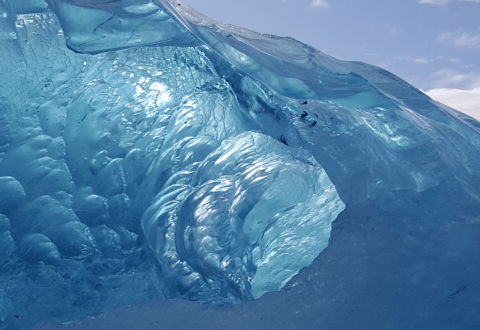
There is something magical about seeing your first iceberg. The twisting and carved designs they form into, a steadfast uncertainty to their nature, they conjure an ancient feeling. They are majestic and make us feel all the power of nature and how small we are. Staring at these gentle giants is mesmerising. It is like seeing an incredible slow-motion ballet as your boat dances around them.
A last vestige of pristine wilderness inaccessible to cruise ships and normal expeditions. It is an incredible region called the ‘Arctic Riviera” due to the beauty of its landscapes.
Here, we will be visiting the easter-coast of course but we will also take you by air where very few explores ever go: into Greenland’s mainland to discover the incredible landscapes untouched by men.

During the trip, you will surely quickly become an iceberg aficionado. It’s like discovering, over and over, something which is the same and yet completely different. You will be comparing them, always on the outlook for one that will be more magnificent than the last.